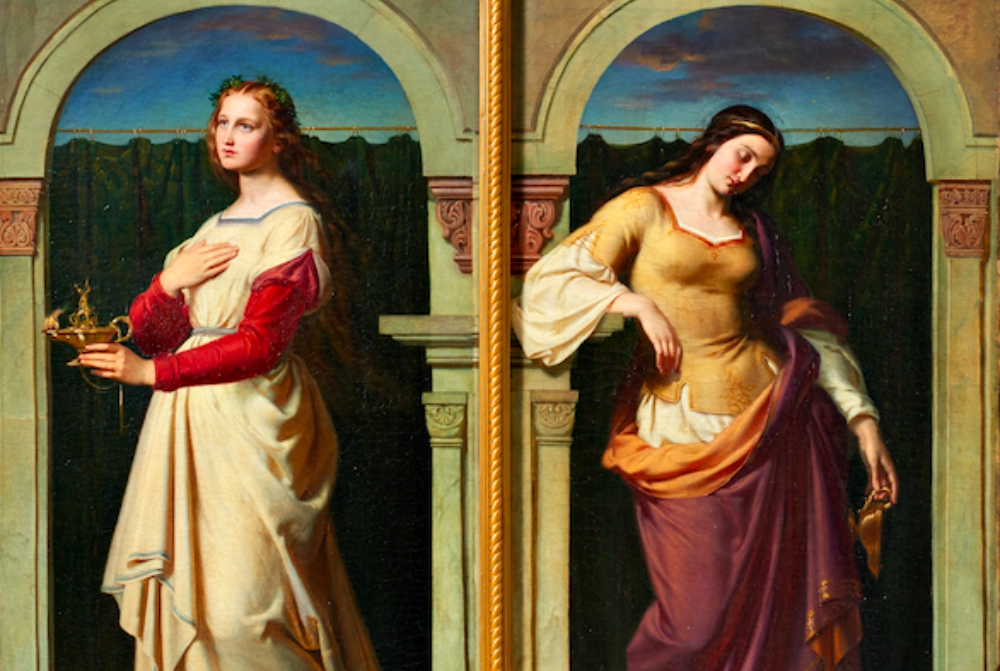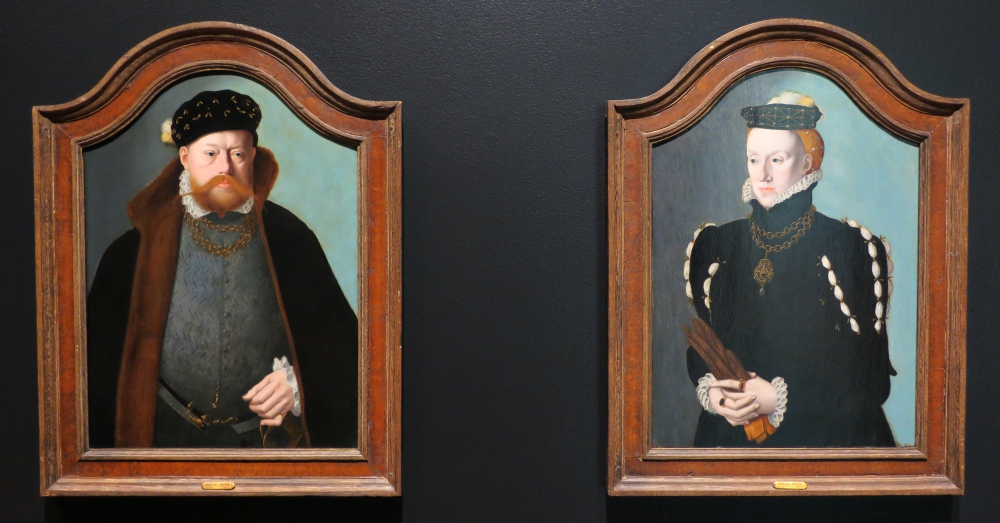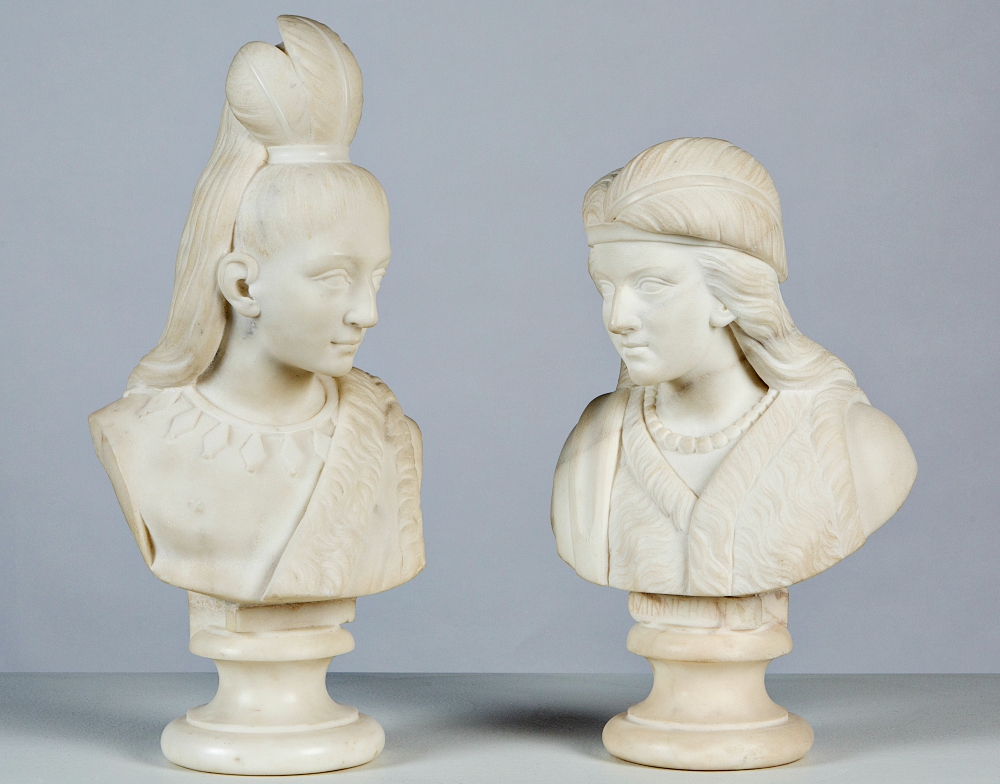
Julius Rotermund (1826-59), "The Wise and Foolish Virgin," 1856, oil on canvas, detail (Brigham Young University Museum of Art)
Juxtaposing and throwing multiple images into conversation may occur casually in photo albums or algorithmically on social media. But the diptych or pendant format, wherein comparison and contrast of adjacent pictures reveals deeper symbolism, dates back centuries.
The exhibit "Power Couples: The Pendant Format in Art" (through Dec. 8) at the Utah Museum of Fine Arts, which gathers 60-odd artworks spanning from the 16th century to the present, demonstrates the ways that pendants featured religious themes from the start.
To understand pendants, said Leslie Anderson, the University of Utah museum's curator of European, American and regional art and the exhibition curator, one must consider their positional hierarchy. Figures on the viewer's left (the pictorial right, or "dexter") are privileged over those on stage right ("sinister") — a Renaissance convention that derives from the good thief's relationship to Christ at the crucifixion.
This choreography places husbands in privileged positions and wives in lesser ones, as in two circa 1555-65 portraits by German artist Barthel Bruyn the Younger from the museum's collection. Both the gentleman, in the dexter position, and the lady are richly dressed. The man, in the space reserved for holy figures, looks forward and is depicted as the object of the spousal devotion of the lady. The pictures are secular, strictly speaking, but the wife's clasped hands suggest prayer.

Barthel Bruyn the Younger (German, circa 1530–1607/10), "Portrait of a Gentleman" and "Portrait of a Lady," both circa 1555-65, oil on panel (Utah Museum of Fine Arts)
There are exceptions to these conventions, Anderson notes. Piero della Francesca's late 15th-century "The Duke and Duchess of Urbino Federico da Montefeltro and Battista Sforza" at the Uffizi Gallery, for example, portrays Sforza posthumously, and as such, her superior position reflects her passage to a different realm. A work by the early Netherlandish painter Quentin Massys portrays a woman, who is trying to seduce the companion male figure, on the viewer's left, because she is breaking societal norms, according to Anderson.
"The diptych develops in late antiquity and in early Christianity as a way to tell biblical narratives that were related or to depict spiritual figures, and then it gains in momentum of course during the medieval period and is well-suited for devotional pieces," Anderson said.
In the pendant exhibition, several other works feature religious content and themes.
Two 1754 paintings, by French painter Charles François Lacroix de Marseille, show the red-and-white flag of the Catholic military Order of St. John on ships. African American and Ojibwa artist Edmonia Lewis created two marble sculptures of "Hiawatha" and "Minnehaha" (both 1868), based on the 1855 Henry Wadsworth Longfellow poem about the union of two fictional figures from warring tribes: an Ojibwa warrior and a Dakota woman. Catholic missionaries convert Hiawatha to Christianity, Anderson writes, and the poem "reinforced misguided notions of the 'vanishing American Indian,' aligned with the 19th-century national myth of 'Manifest Destiny.' "

Edmonia Lewis (American, 1844-1907), "Hiawatha" (1868), marble, and "Minnehaha" (1868), marble (Utah Museum of Fine Arts)
A fascinating pendant in the exhibit is German artist Julius Wilhelm Louis Rotermund's "The Wise and Foolish Virgin" (1856), from the Brigham Young University Museum of Art. The separate canvases, which are framed together, follow the Matthew 25 parable. Having prepared, the wise virgins meet the bridegroom, while the foolish ones, who tarry purchasing oil, are barred from the banquet.
Rotermund's predecessors had depicted this scene in a particular way. In the early 15th century, the so-called Alexander Master's manuscript illumination shows 10 nearly identical virgins, distinguished only by their lit or extinguished lamps. The sculpted virgins, circa 1245, at the Cathedral of Sts. Catherine and Maurice in Magdeburg, Germany, are also similarly attired; the wise smile and put their hands to their hearts, while the foolish scowl or weep. William Blake's circa 1799-1800 watercolor and pen-and-ink drawing casts a shadow over the foolish five, while the wise ones are illuminated.
The art historical precedent here makes Rotermund's picture all the more unusual. The artist, who died around age 33 some three years after making the painting, portrays a single wise and a single foolish virgin. The two stand in identical arched doorways before green curtains, but the women are a study in contrasts.
Advertisement
The wise woman on the dexter-left, who wears a laurel wreath in her light hair, holds a lit oil lamp decorated with St. George slaying the dragon in her left hand while pressing her right hand to her heart. She holds her head high, in stark contrast to the other, whose wreath has fallen from her dark hair and lies underfoot. Her eyes closed, she steadies herself on a column with her right elbow, as her extinguished lamp droops at her side.
Ashlee Whitaker, the BYU museum's curator of religious art, notes religious subjects were common to 19th century Dresden school artists, but little is known about Rotermund, including his religious beliefs.
At first glance, viewers don't necessarily understand the picture. "The two figures invite the viewer to conceptually search beyond the narrative of the parable and to focus on the symbolic principles embodied by each woman," Whitaker said. The foolish virgin's posture, on the verge of falling asleep standing up, is particularly significant.
"She certainly has more worldly trappings," among them a more crafted dress neckline, the fallen wreath, and the lamp in jeopardy, but she doesn't seem to be too far gone in her slumber, to Whitaker.
"Maybe it was just a little bit too much vanity and a little bit too much distraction," she said. "It bespeaks of often the small things, the subtle omissions, that may occur to point us away from our true moral compass or our faith. She's fallen asleep on the job, but perhaps there's still a chance she'll wake up before that lamp falls."
BYU museum director Mark Magleby thinks the foolish virgin's lavish fabrics demonstrate "an innocent lack of control" as they begin to slip. "It isn't lascivious, but it is, to my eye, quite sensuous," he says. "It feels like some of the depictions of Mary Magdalene before she became a follower of Christ."
The wise virgin, meanwhile, wears the robe of a religious order over her expensive clothes. He hasn't been able to find the depicted robe in use in the artist's lifetime, but Magleby is drawn to the way Rotermund showed the wise virgin's former and future attire in a way that "only signify in contrast to each other."
[Menachem Wecker is a freelance journalist based in Washington, D.C.]








